Samenvatting
Samenvatting International Economics
- Instelling
- Universiteit Antwerpen (UA)
Dit document bevat een volledige samenvatting van alle slides en lesnotities van het vak International Economics. Deze samenvatting werd opgesteld in en is dus up-to-date. Met behulp van deze samenvatting behaalde ik een score van 16/20 in januari . Veel succes xxx
[Meer zien]



